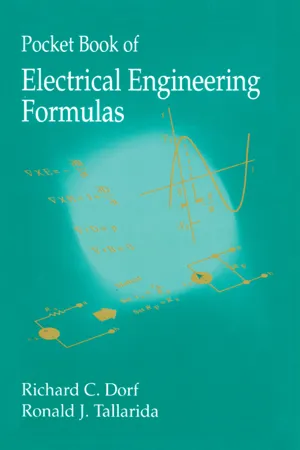Determinants
Determinants are a mathematical concept used to associate a scalar value to a square matrix. They are used to determine whether a matrix is invertible and to solve systems of linear equations. The determinant of a matrix A is denoted as det(A) or |A|.
5 Key excerpts on "Determinants"
- eBook - ePub
- Michael Harrison, Patrick Waldron(Authors)
- 2011(Publication Date)
- Routledge(Publisher)
...Determinants DOI: 10.4324/9780203829998-4 2.1 Introduction In Chapter 1 we defined a matrix, saw a few examples of how systems of linear equations and matrices arise in economic and financial applications, and presented the basic operations and rules of matrix algebra, paying attention to the proofs of many of the matrix properties that were stated. We also catalogued a number of special types of matrix that we will encounter later. In this chapter, we introduce the concept of a determinant, which is important in the theory and solution of systems of linear equations. The determinant also provides us with a means of obtaining an explicit formula for evaluating the inverse of a matrix. At a basic level, we can describe a determinant as a real-valued function of a square matrix variable, i.e. a function that associates a real number f (A) with a square matrix A. Formally, we may write f : M → ℝ, where M is the set of square matrices and ℝ is the set of real numbers. However, we require a more precise definition that will also allow us to calculate the numerical value of f (A). Before we give this, we need to be clear on a few preliminary ideas. 2.2 Preliminaries 2.2.1 Permutation The idea of a permutation of some number, r, of integers from the set of integers {1, 2,..., n } is fundamental. As discussed on p. xxiii, a permutation is an ordered arrangement of r of the first n integers. The number of such different permutations, n P r, is given by the general result n P r = n ! (n − r) ! (2.1) defined on p. xxiii, from which it follows that n P n, the number of ordered arrangements of all n integers, is n !, since (n – n)! = 0! ≡ 1. Of these n ! permutations, the typical permutation, i.e. the j th, may be denoted by j 1 j 2... j n. 2.2.2 Inversion An inversion in a permutation of n integers occurs whenever a larger integer precedes a smaller one in the permutation...
- eBook - ePub
- Richard C. Dorf, Ronald J. Tallarida(Authors)
- 2018(Publication Date)
- CRC Press(Publisher)
...2 Determinants, Matrices, and Linear Systems of Equations 1. Determinants Definition. The square array (matrix) A, with n rows and n columns, has associated with it the determinant det A = | a 11 a 12 ⋯ a 1 n a 21 a 22 ⋯ a 2 n ⋯ ⋯ ⋯ ⋯ a n 1 a n 2 ⋯ a n n |, a number equal to ∑ (±) a 1 i a 2 j a 3 k ⋯ a n l where i, j, k,…, l is a permutation of. the n integers 1,2,3,… n in some order. The sign is plus if the permutation is even and is minus if the permutation is odd (see 1.12). The 2 × 2 determinant | a 11 a 12 a 21 a 22 | has the value a 11 a 22 − a 12 a 21 since the permutation (1,2) is even and (2,1) is odd. For 3×3 Determinants, permutations are as. follows: 1, 2, 3 even 1, 3, 2 odd 2, 1, 3 odd 2, 3, 1 even 3, 1, 2 even 3, 2, 1 odd Thus, | a 11 a 12 a 13 a 21 a 22 a 23 a 31 a 32 a 33 | = { + a 11 ⋅ a 22 ⋅ a 33 − a 11 ⋅ a 23 ⋅ a 32 − a 12 ⋅ a 21 ⋅ a 33 + a 12 ⋅ a 23[. --=PLGO-SEPARATOR=--]⋅ a 31 + a 13 ⋅ a 21 ⋅ a 32 − a 13 ⋅ a 22 ⋅ a 31 } A determinant of order n is seen to be the sum of n! signed products. 2. Evaluation by Cofactors Each element a ij has a determinant of order (n −1) called a minor (M ij) obtained by suppressing all elements in row i and column j. For example, the minor of element a 22 in the 3 × 3 determinant above is | a 11 a 13 a 31 a 33 | The cofactor of element a ij, denoted A ij is defined as ± M ij, where the sign is determined from i and j : A i j = (− 1) i + j M i j. The value of the n × n determinant equals the sum of products of elements of any row (or column) and their respective cofactors...
- eBook - ePub
- Arsen Melkumian(Author)
- 2012(Publication Date)
- Routledge(Publisher)
...For example, if matrix A has a dimension of 4 × 4, then where the cofactors are third-order Determinants. Evaluation of higher-order Determinants can also be reduced to evaluation of third-order Determinants. 6.2.1 Properties of Determinants The following properties of Determinants can be used to simplify the process of evaluating of a determinant. P ROPERTY 6.1 If a matrix has a row (column) of zeros, then the determinant is zero. E XAMPLE 6.24 This property follows immediately from the Laplace expansion (expand | A | by the second column). P ROPERTY 6.2 If a multiple of any row (column) is added to another row (column) of a matrix, then the determinant remains unchanged. E XAMPLE 6.25 P ROPERTY 6.3 A matrix with two identical rows (columns) has a determinant equal to zero. E XAMPLE 6.26 This property is an immediate consequence of Properties 1 and 2. P ROPERTY 6.4 A matrix that has two rows (columns) that are multiples of each other has a determinant that equals zero. E XAMPLE 6.27 Here the second row is the multiple of the first one (R 2 = 5 · R 1). P ROPERTY 6.5 Interchanging two. rows (columns) of a matrix changes the sign, but not the absolute value, of the determinant. E XAMPLE 6.28 P ROPERTY 6.6 The determinant of the transpose of a matrix is equal to the determinant of the matrix (| A ′| = | A |). E XAMPLE 6.29 P ROPERTY 6.7 Multiplying a row (column) of a matrix A by a constant k multiplies the determinant by a factor of k. E XAMPLE 6.30 P ROPERTY 6.8 If A is a triangular or diagonal matrix of order n × n, then the determinant equals the product of the elements of the main diagonal: E XAMPLE 6.31 Determinants have many important applications, including solving systems of linear equations. 6.3 The matrix of cofactors D EFINITION 6.3 Let A be a square matrix of order n × n...
- eBook - ePub
- Colin Hansen(Author)
- 2018(Publication Date)
- CRC Press(Publisher)
...equal to the sum of the products of the elements and their cofactors along any column or row. For example, the determinant of the (3×3) matrix, A, above can be found by adding the products of the elements and their cofactors along the first row: | A | = a 11 C 11 + a 12 C 12 + a 13 C 13 (A.31) Therefore, the determinant of a large square matrix can be broken up into a problem of calculating the Determinants of a number of smaller square matrices. If two matrices, A and B, are square, then: | A B | = | A | | B | (A.32) A matrix is said to be singular if its determinant is equal to zero. A.7 Rank of a Matrix The rank of the (m × n) matrix, A, is the maximum number of linearly independent rows of A and the maximum number of linearly independent columns of A. Alternatively, the rank of A is a positive integer, r, such that an (r × r) submatrix of A, formed by deleting (m – r) rows and (n – r) columns, is non-singular, whereas no ((r + 1) × (r + 1)) submatrix is non-singular. If the rank of A is equal to the number of columns or the number of rows of A, then A is said to have full rank. A.8 Positive and Non-Negative Definite Matrices A matrix, A, is said to be positive definite if x H Ax is positive for all non-zero vectors, x ; if x H Ax is simply non-negative, then A is said to be non-negative definite. For A to be positive definite, all of the leading minors must be positive; that. is: a 11 > 0 ; | a 11 a 12 a 21 a 22 | > 0 ; | a 11 a 12 a 13 a 21 a 22 a 23 a 31 a 32 a 33 | > 0 ; …, etc (A.33) For A to be non-negative definite, all of the leading minors must be non-negative. A.9 Eigenvalues and Eigenvectors Let A be a (square) (n × n) matrix. The polynomial, |λ I – A | = 0, is referred to as the characteristic equation of A. The solutions to the characteristic equation are the eigenvalues of A. If λ i is an eigenvalue of A, then there exists at least one vector, q i, that satisfies the relationship: A q i = λ i q i (A.34) The vector, q i, is an eigenvector of A...
- F. Xavier Malcata(Author)
- 2020(Publication Date)
- Wiley(Publisher)
...In the case of Eq. (1.10), the representation is selected because the underlying set of algebraic equations, see Eqs. (1.1) and (1.2), holds indeed as coefficient matrix. If a set of p algebraic linear equations in p unknowns is considered, viz. (1.18) then the concept of determinant can be extended in very much the same way to produce (1.19) however, the mode of calculation of higher order Determinants is more complex – as it requires previous conversion to p !/2 second‐order Determinants (as will be explained in due course), with calculation of each one to follow Eq. (1.17)....




